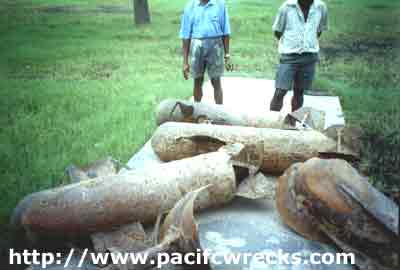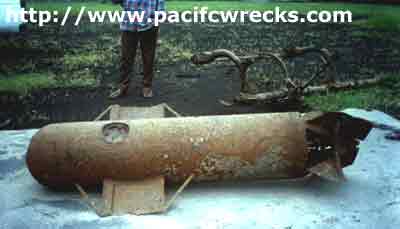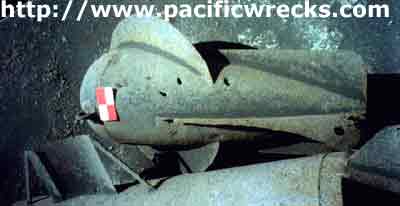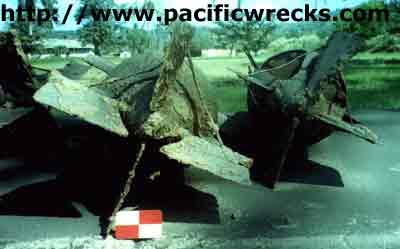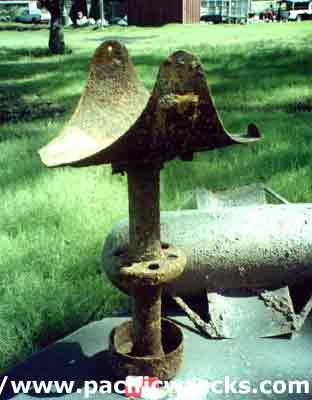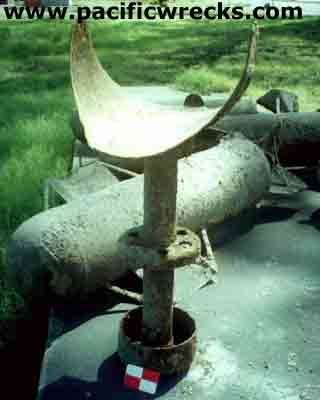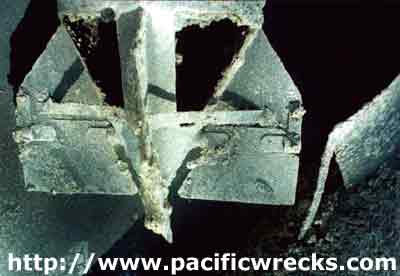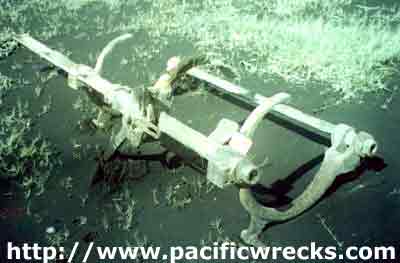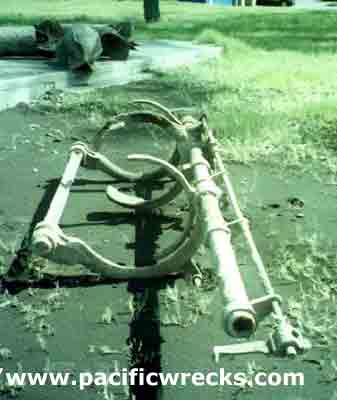Two hydrovanes were recently
found in a tunnel at Malaguna near Rabaul.
The entrance was exposed by heavy rain. Rough dimensions are ~13" diameter by ~66". They were found with some anti-mine hydrovanes, and a small ‘stool’
type cradle is at front left.
This photo shows at right what appear
to be ship deck torpedo launch frame or cradle. When I first saw the
cradle I thought it may have been an aircraft torpedo launch cradle,
but it is solid steel and takes 4-5 grown men to move it! There is
some red paint still on the release mechanism. Apparently there are
lots more things in the tunnel.
A small hydrovane. How they worked can
be seen on this view: a hawser would be attached to the eye and when
towed by a minesweeper it would move out sideways from the boat (I
assume they would have 2 - one port one starboard), cutting mines
free. They usually have a valve somewhere on them to add compressed
air or water(?) to set the depth at which they would be neutrally buoyant.
These are very common around Rabaul often used as gate posts and boundary
markers. I assume after the war they were recognized as not explosive,
so were not removed or dumped at sea, hence so many survived. That
knowledge has been lost and now people view them with suspicion, many
that came to light after the eruption were removed as 'bombs' They
vary in size some being quite large. This one has shrapnel damage,
did its hawser hit a mine? Also note the hollow aerofoil shape of
the torpedos' wing construction at bottom left of photo.
The 'Stool' like cradle. The width of
the gap between the 'ears' is 47cm (18.5"). The up standing lip
at the back seems original so it can't have been for a complete torpedo.
For working on just the war-head perhaps? Perhaps a large calibre
shell cradle, before being pushed into a gun? did the 'stool' sit
in a socket on the floor so it could rotate? Note holes at top of
vertical ears (for a strap?) If it was a bit bigger and had a lip
both ends.
They have a circumference of 108 cm so diameter
of 34.3 cm (13.5"). Movable flaps on the vertical stabilizers
can be clearly seen on left one and the one left back ground. Also
note no hole at apex of tail cone, there is an iron threaded plug
in a small hole.
Detail of mechanism in tail cone, central
shaft with two brass lock nuts holding a spring against main body.
The shaft appears to be solid and is linked by two cams to the vertical
stabilizer flaps. Perhaps the spring is to centralize the stabilizers,
or is it the plunger for the detonator? ie the spring depressed on
impact throwing the pin forward. Where were the fuses in regular torps.?
There appears to be no propulsion mechanism, did the thing simply
rely on the forward momentum of the aircraft?
Shows the release cradle.
I assume the big long tube is the top and the short angle iron the
base. In the center there are big pincer like claws for holding and
releasing the torp they are 18" wide. These claws would have
been opened by the big lever on top or by pulling or pushing a pistol
grip at the end of the main round shaft. There are also two horizontal
shallow 'c's on the top tube to stop fore and aft swinging of the
torp, again they are 18" from horn to horn. The moving parts
are held in large '?' shaped divots, like lifeboat divots, joined
at the bottom by angle iron and at the top by the main tube. Notice
the outward pointing lugs on the upper rear of these '?' shaped pieces.
